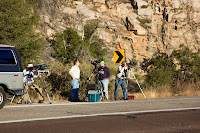 |
| Click to enlarge |
This marks year two that I have participated in a small winter tradition among a few local amateur astronomers- That is taking pictures of the Sun setting behind Kitt Peak National Observatory, as seen from the Mount Lemmon highway. I posted a few pictures from
last year, exactly one year ago today.
Dean Ketelsen is the originator and organizer of this annual tradition and he is also the inspiration for the start of this blog! You can see him at left, in the image at left, as we prepared for the sunset. Also in the image are Dean's colleague Roger, his wife Melinda, and my good friend Jon. It is due in small part to Dean that I am posting this report within a couple hours of our trip...he threw down the gauntlet as his parting words this evening were that he was looking forward to a blog post- so Dean, here you are!
I had planned to take an image every ten seconds and then make a time lapse- I set up a tracking mount along with my Stellarvue 90mm triplet refractor, a Lunt Herschel Prism, and my Canon T2i with a 2x Barlow lens. As the Sun dipped toward the horizon I made sure everything was set- and sadly, I forgot to turn off the tracking! So instead of the telescope remaining fixed on the summit observatories, it continued to track on the sun as the observatories slowly drifted up out of the field of view! Regardless I ended up with a few nice images which I present here. As you can see we had a large number of clouds drifting through and it made for some very photogenic moments.
First up, are two images of the Sun as it was descending behind Kitt Peak. As always, click them to enlarge to full size and if your browse automatically resizes images, you may need to click them again.
Next, I was delighted to discover when going through my pictures that I captured the Green Rim! Many have heard of the elusive "Green Flash" which is actually a distortion of the Sun's green rim. The short explanation for this is that our atmosphere acts similarly to a prism as the Sunlight moves through it toward us, and the suns light is refracted and spreads out much like in a rainbow. While you may expect the rim to be blue, similar to the rainbow, our atmosphere scatters much of the blue light and we are left with the upper limb of the Sun appearing greenish. When most of the Sun is below the horizon and it is no longer overwhelmingly bright, we can often see this green rim with the magnification supplied by binoculars or a telescope.
Finally, once I pulled the camera from the telescope, I put a 24-105 zoom lens on with a polarizing filter and took the image below at the 105mm setting. It was 1/500 of a second at f/4.
This was so fun, I may try again on the 24th. In case you are wondering how we could have a second opportunity to find the Sun setting in the same place on the horizon within a week...we are approaching the winter solstice in approximately 3 days. At solstice, the Sun reaches its most southerly point in our sky and then begins its trek northward...so about 3 days after solstice it will again be setting behind KPNO.
 The winds died down, finally, very early this morning and when I went outside to check on conditions for Solar observing saw that high cirrus were beginning to form as a predicted front moves in. As many observers know, sometimes a very thin layer of cirrus clouds can provide favorable observing conditions for bright targets such as the Sun (or Jupiter)- I set up my Stellarvue 90mm triplet with Lunt Herschel Prism and sure enough the views of the Sun were quite stable. While there is virtually no activity in the northern hemisphere, the southern hemisphere had numerous spots stretching in a band within 15 degrees of the equator. At left is a white light image from the Solar Dynamics Observatory taken this morning. Clicking on the image will bring it up full size and includes the NOAA active region numbers within which the current sunspots exist. In addition, there is a scale at lower right to provide a sense of the size of spots relative to the Earth and Jupiter.
The winds died down, finally, very early this morning and when I went outside to check on conditions for Solar observing saw that high cirrus were beginning to form as a predicted front moves in. As many observers know, sometimes a very thin layer of cirrus clouds can provide favorable observing conditions for bright targets such as the Sun (or Jupiter)- I set up my Stellarvue 90mm triplet with Lunt Herschel Prism and sure enough the views of the Sun were quite stable. While there is virtually no activity in the northern hemisphere, the southern hemisphere had numerous spots stretching in a band within 15 degrees of the equator. At left is a white light image from the Solar Dynamics Observatory taken this morning. Clicking on the image will bring it up full size and includes the NOAA active region numbers within which the current sunspots exist. In addition, there is a scale at lower right to provide a sense of the size of spots relative to the Earth and Jupiter.














